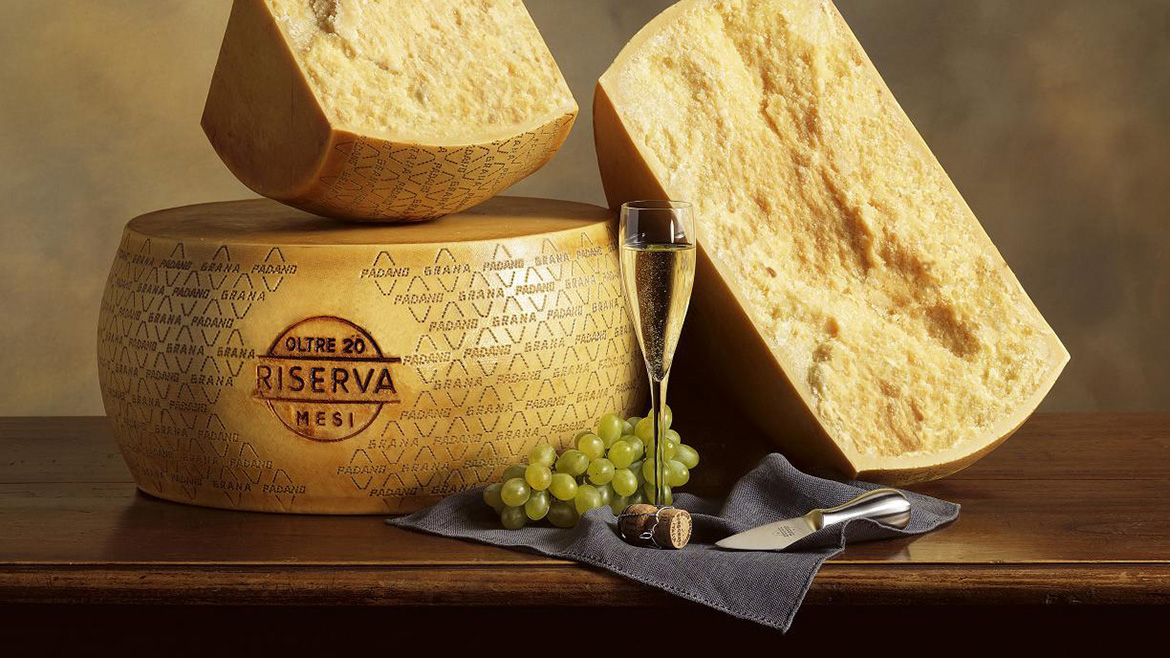Characteristics
Production zone
Provinces of Alessandria, Asti, Cuneo, Novara, Torino, Vercelli, Bergamo, Brescia, Como, Cremona, Mantova (left side of the Po), Milano, Pavia, Sondrio, Varese, Trento, Padova, Rovigo, Treviso, Venezia, Verona, Vicenza, Bologna (right side of the Reno), Ferrara, Forlì, Piacenza and Ravenna.
Characteristics
Cheese of cow’s milk, half-fat, with hard, cooked dough and slow maturation.
Shape and Dimensions
Cylindric shape, on the high (slightly convex) is impressed the official protection mark. It has a diameter of 35 to 45 cm, it is 18 to 25 cm high and weighs 24 to 40 kilos. Dark and oily rind, 4-8 mm thick.
Looks of the dough
The dough is pale yellow. It is finely granular, and breaks in chips.
History
The first news about a then unnamed cheese have been found in documents of the year 1000, when the Cistercian Monks of Chiaravalle (near Milan) started a land reclamation that made possible forage cultivation and breeding of bovines. In the Middle Ages the problem with cheeses was that they couldn’t be preserved; so the medieval cheese-makers developed a particular technique to increase their preservation: this is how Grana was born. From that moment we know about Grana making near the Po river, the Ticino, the Adda; in the XIII century Benvenuto from Imola described it as “the longest-lasting and resisting to diseases”.In 1477 Pantaleone from Confienza described Grana from Piacenza as the gratest Italian cheese.
Production technique
Once the makers made two makes a day; now there usually is only one. It is made with cow’s half-fat milk, skimmed and put in big copper boilers, where serum and technological coadjuvant (lisozime) are added.Then the dugh is warmed up to 32° C and rennet is added. After 20-30 minutes the curd is broken with a thorn in pieces as big as a rice grain, and the mix is cooked at 55° C. The pieces that stick to the bottom of the boiler are gathered and put under a weight.After being turned around some times, the moulds are pickled for around 20 days.The seasoning lasts at least 12 months (after nine months the cheese is beaten, and if it has the required characteristics, marked).
Taste and smell
Fragrant, intense and delicate flavora due to the long seasoning, that remember milk, forage and toasted. In the mouth it feels friable and granular, its taste is intense and balanced thanks to the actively degrading proteins.
How to eat it
Alone in dishes or grated on pasta and other.
Recommended wines
Barolo, Barbaresco, Roero, Nebbiolo d’Alba
ONAF
L’ONAF (Organizzazione Nazionale Assaggiatori di Formaggi), nata nel 1989 in Piemonte dove ha tuttora le sede nel prestigioso Castello di Grinzane Cavour (CN), si propone la diffusione della conoscenza e del corretto assaggio dei formaggi. Conta circa Assaggiatori. L’ONAF è presente in tutta Italia, isole comprese, attraverso quindici Delegazioni Interprovinciali. Si diventa soci iscrivendosi all’ONAF, si diventa Assaggiatori e Maestri dopo aver superato con profitto i corsi di studio di 1° e 2° livello, che danno diritto ai relativi distintivi color argento e oro.
ONAF (Organizzazione Nazionale Assaggiatori di Formaggi - National Association of Cheese Tasters), has as an aim the diffusion of knowledge of cheese and of correct tasting methods. It has about 1500 members, divided in: Members, Tasters and Master Tasters. ONAF has fifteen Delegations in fifteen regions. To become a member it's enough to pay an annual free, to become Tasters and Master Tasters it's necessary too participate to the first- and second-level courses and to pass a final exam
Posts by
|

